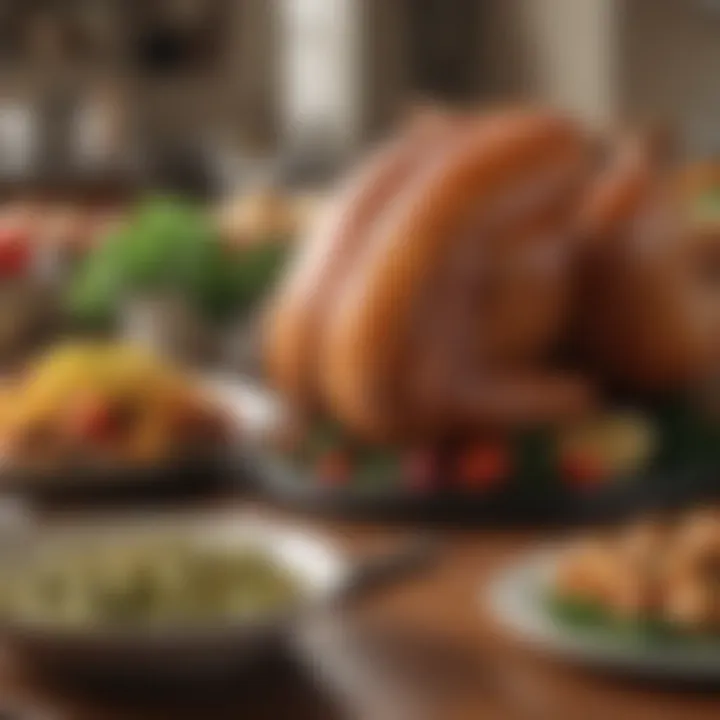In-Depth Analysis of Gobble Meal Pricing Structure


Intro
Understanding the pricing of meal kits is essential for both consumers and businesses in the evolving food industry. Gobble, a popular meal kit service, has garnered attention for its unique approach to delivering high-quality meals. This section will explore various aspects of Gobble’s pricing structure, offering insights into how it compares with its competitors, along with factors that affect the price of each meal.
This exploration will also touch on customer perceptions of value in relation to pricing, diving into what users deem worth the cost and how these perceptions shift in today’s market. By looking closely at statistical data and qualitative feedback, one can develop a clearer picture of the dynamics at play in the meal kit sector, particularly with Gobble’s offerings.
Understanding Gobble as a Meal Service
Understanding Gobble as a meal service is fundamental for grasping its pricing structure and overall consumer appeal. This section provides context on what Gobble offers and how it positions itself in the competitive meal kit industry. Through a detailed overview, we can identify not only the services provided but also the unique selling points that differentiate Gobble from its competitors. This understanding is crucial in discerning the value proposition that customers potentially gain from their interaction with the brand.
Overview of Gobble
Gobble operates as a meal kit delivery service that focuses on providing quick, simple, and high-quality culinary options. The service caters primarily to busy individuals and families that seek convenience without compromising on the quality of food. Customers can select from a diverse menu that changes weekly, which encourages them to explore new dishes and cuisines.
Each meal kit generally includes pre-prepped ingredients, reducing the cooking time significantly. This aspect of Gobble is particularly appealing as it offers meals that can be prepared in about 15 minutes.
• The meal kits are designed to serve two or four people.
• Customers can manage their subscriptions with flexibility, allowing for meal choices to be paused or skipped.
• Gobble emphasizes the use of seasonal ingredients, which speaks to a wider trend towards sustainability and health-conscious eating.
This structure not only meets the demands for convenience but also aligns with current lifestyle trends, making Gobble an attractive option for consumers.
Gobble’s Unique Selling Proposition
The unique selling proposition (USP) of Gobble lies in its focus on speed and quality. While many meal kit services provide basic meal options, Gobble sets itself apart by combining minimal prep time with robust, flavorful meals. The following points highlight Gobble's USP:
- Speedy Preparation: The hallmark of Gobble’s service is its 15-minute meal prep time, positioning it as a quick solution for mealtime.
- Premium Ingredients: Gobble is committed to sourcing high-quality ingredients, ensuring that customers receive fresh and flavorful meals.
- Diverse Menu Options: The variety offered in the weekly menu allows customers to break away from routine dishes, promoting culinary exploration.
- Sustainability Focus: Gobble integrates sustainable practices by utilizing seasonal produce and minimizing food waste through careful ingredient portions.
In summary, understanding Gobble’s unique offerings provides insight into how the company has crafted a compelling business model that appeals to contemporary consumers. This foundation sets the stage for analyzing the pricing strategy that reflects these values and promises.
Pricing Structure of Gobble
Understanding the pricing structure of Gobble is critical to grasping how it positions itself in the meal kit delivery market. Pricing is not just a number; it reflects the overall value and service quality perceived by consumers. The cost of meals can affect a brand's image and its appeal to potential customers. By dissecting Gobble's pricing, we can understand how it competes with other players and what customers can expect for their investment.
Pricing also encompasses various aspects, such as meal base prices, ingredients, and additional shipping costs. In today's market, transparency regarding costs has become essential. Consumers appreciate knowing what their money is going toward. Understanding memberships versus one-time purchases can further help in identifying the best options for various consumer needs. These factors contribute significantly to the discussion about value and investment in meal services.
Base Prices for Meals
Gobble’s base prices for meals are a foundational element of its pricing structure. Each meal typically ranges from $10 to $13 per serving, depending on the recipe and ingredients involved. This pricing aims to strike a balance between quality and affordability.
The base price reflects not only the ingredients but also the preparation and delivery. Customers need to consider what they receive in exchange for that price. Gobble emphasizes convenience, offering meals that require minimal preparation time. The cost must, thus, align with these expectations.


Cost Breakdown: Ingredients and Shipping
When analyzing costs, breaking down the price is essential. Each meal's price includes the cost of high-quality ingredients. Gobble often sources seasonal and fresh produce, which may influence meal prices based on availability. The type of protein, vegetables, and other components can dictate how much a meal costs.
Additionally, shipping costs could vary by location. For instance, customers near distribution centers might see lower shipping fees compared to those in remote areas. Understanding these variations helps consumers make informed decisions about their meal choices.
Membership vs. One-Time Purchases
The choice between a membership and one-time purchases significantly affects overall expenditure. Gobble offers a subscription service which can lead to savings in the long run.
For frequent users, subscribing can provide cost benefits as members often receive discounted rates. In contrast, one-time purchases allow more flexibility. This can appeal to consumers who want to try out the service without committing long-term.
By evaluating the differences and benefits, consumers can choose an option that best fits their meal planning needs.
The pricing structure at Gobble illustrates how they aim to cater to different customer interests and needs in the competitive meal kit landscape.
Comparative Analysis of Competitive Pricing
In the realm of meal delivery services, understanding pricing is crucial for potential consumers and businesses alike. This comparative analysis of competitive pricing provides insights that go beyond the obvious numbers. It helps consumers make informed choices. Furthermore, it identifies where Gobble stands in relation to its competitors in terms of value and quality.
Comparing prices among different services takes several factors into account. Such elements include the quality of ingredients, portion sizes, dietary options, and customer service. Consumers increasingly seek to find not only the most affordable option but the one that provides the best value. Price is not the only determinant; customer experience is significant too. If the food is not satisfactory or the delivery is inconsistent, even a low price may not attract repeat customers.
Comparing Gobble to Major Competitors
When considering Gobble, it is essential to analyze its pricing in the context of major competitors such as Blue Apron, HelloFresh, and Sun Basket. Each of these services has unique features. For instance, Blue Apron is well-regarded for its culinary creativity, whereas HelloFresh emphasizes convenience.
- Base Meal Price: Gobble often positions itself as a premium offering. Typically, it charges around $11.99 per serving. In comparison, HelloFresh might charge approximately $8.99 per serving, making it a more economical choice. However, the difference in preparation time and ingredient quality plays a significant role in consumer decisions.
- Dietary Flexibility: Both Gobble and Sun Basket cater to dietary restrictions. However, Sun Basket is often seen as more accommodating regarding various diets such as paleo or keto, which may affect its pricing structure. Consumers looking for diverse meal options might weigh these factors heavily.
- Ingredient Quality: Gobble prides itself on using high-quality ingredients. While this does lead to a higher price point, many customers value this aspect, believing that better ingredients lead to better meals. This perception of value can justify the price difference.
The general consensus about Gobble is that its prices may be higher, but many customers find the time saved is worth the cost. By minimizing preparation time to just 15 minutes, Gobble caters to busy professionals who prioritize convenience.
Market Trends and Consumer Preferences
Market trends indicate a growing preference for fresh, home-cooked meals amid busy lifestyles. Consumers are increasingly favoring meal kit delivery services like Gobble over traditional grocery shopping. Thus, understanding underlying consumer preferences is vital for businesses in this space.
- Rise in Health Consciousness: There is a notable shift towards healthier eating options. Consumers are more aware of nutritional content than ever before, and they desire transparency regarding meal ingredients. This trend is influencing pricing strategies, as companies must balance cost with quality and health benefits.
- Impact of Economic Conditions: Economic fluctuations impact consumers' willingness to spend. In times of economic uncertainty, potential buyers may scrutinize their options. Pricing models that include flexible subscriptions or promotional offers can become significant. Gobble should consider these trends when developing marketing strategies.
- Environmental Considerations: Sustainability has become a driving factor in consumer decisions. Many are now looking at the ecological footprint of their meal choices. Companies that align with these preferences by offering sustainable packaging and ethical sourcing of ingredients may gain a competitive edge, allowing for potential price increases if justified by consumer perception.
"Understanding the market dynamics and consumer preferences is key for Gobble to effectively position itself within a competitive landscape."
In summary, analyzing Gobble's pricing compared to competitors reveals many nuanced factors. Identifying these elements provides not only clarity for consumers but also strategic insight for the meal service industry. Consumers continue to weigh price against quality, convenience, and ethical considerations, further complicating straightforward pricing strategies.
Value Perception Among Customers


Understanding the perception of value by customers is essential in analyzing Gobble's pricing per meal. Value perception encompasses how customers interpret the worth of the meals they receive based on the quality of ingredients, the convenience of service, and the overall experience. In a saturated meal service market, the perceived value can often dictate customer loyalty and satisfaction.
A positive value perception leads to enhanced customer retention and potentially attracts new users through recommendations and organic word-of-mouth. As Gobble focuses on high-quality products and streamlined meal prep, identifying what customers prioritize helps inform ongoing service enhancements and pricing strategies.
Being aware of customer sentiment can assist Gobble in shaping future offerings to better align with consumer expectations. This is vital as fluctuating market conditions may affect ingredient pricing, and customers may become more price-sensitive during economic downturns.
Customer Feedback and Satisfaction Surveys
Gobble actively seeks insights through customer feedback and satisfaction surveys to gauge market reaction to their meals. This qualitative data is invaluable, revealing the strengths and weaknesses of their service. Surveys often ask customers to rate aspects such as meal flavor, portion size, and ease of cooking.
When analyzing the feedback, several critical trends emerge:
- High Satisfaction with Ingredients: Customers frequently appreciate the freshness and quality of the ingredients sourced by Gobble.
- Convenience Factor: Many respondents highlight the ease of meal preparation, which suits busy lifestyles.
However, not all feedback is positive. Some reviews may indicate dissatisfaction with specific meals or the overall price. Addressing these concerns can lead to improved customer loyalty and higher retention rates.
Quality vs. Cost: Consumer Insights
Consumer insights often pivot around the balance of quality versus cost when evaluating meal services like Gobble. Many customers today are willing to pay a premium for higher quality, organic ingredients and unique recipes. This inclination towards quality can make it challenging for services like Gobble to compete with lower-priced alternatives, even if they provide superior value.
Key considerations include:
- Transparency: Consumers prefer knowing where their food comes from. Gobble's sourcing practices should be clearly communicated.
- Recipe Variety: The diversity of meal options impacts consumer satisfaction. Effective use of surveys can highlight desired cuisines to keep product offerings fresh.
Factors Influencing Price Variations
Understanding the factors that influence price variations is crucial for both consumers and service providers in the meal kit market. For Gobble, several elements play a significant role in determining meal pricing. These factors can provide insights into how Gobble positions itself within the competitive landscape and its value proposition to customers.
It is important to recognize that meal pricing is not entirely static. Instead, it is dynamic and influenced by various external and internal factors. As meal-kit delivery services continue to evolve, the pricing model must adapt to changing consumer expectations, market conditions, and ingredient availability. This adaptability is essential for maintaining a healthy balance between customer satisfaction and profitability.
Seasonal Pricing Adjustments
One key aspect of pricing variations is seasonal adjustments. Seasonality affects ingredient availability and demand. For instance, fresh vegetables may become more abundant and cheaper during summer months, while winter might see increased prices for the same items. Consequently, Gobble might lower or raise prices depending on the season.
- Higher demand seasons: During certain holidays or major events, Gourmet might see a spike in demand, which can also lead to price increases.
- Lower demand periods: Off-peak seasons often see reduced prices as companies aim to maintain sales volume.
These adjustments not only reflect the costs of sourcing ingredients but also the greater consumer appetite for certain dishes at specific times of the year. By offering seasonal meals, Gobble can also entice customers with fresh and timely flavors.
Ingredient Sourcing and Market Fluctuations
Another factor influencing Gobble's pricing is ingredient sourcing. The costs associated with sourcing ingredients can fluctuate based on market demand, availability, and quality. When ingredient prices rise, providers like Gobble must decide whether to absorb the cost or pass it on to customers.


- Local sourcing: Sourcing ingredients from nearby farms can often reduce costs associated with transportation but may not always be feasible year-round.
- Market conditions: Economic factors such as inflation can also impact prices, forcing companies to adjust their pricing strategies accordingly.
It is vital for customers to understand these elements because they directly affect the value they receive. Consumers might prefer to pay slightly more for meals made with high-quality, sustainably sourced ingredients. Similarly, they may appreciate transparent pricing, knowing that seasonal adjustments and sourcing strategies lead to fair pricing.
Marketing Strategies Impacting Price
Understanding the marketing strategies that impact pricing can offer valuable insights for consumers and analysts alike. In the case of Gobble, various tactics are in place to effectively position the brand in a competitive landscape. These strategies not only determine how meals are priced but also influence customer perceptions and sales outcomes.
Promotional Offers and Discounts
Promotional offers and discounts are a fundamental part of Gobble’s pricing strategy. By utilizing limited-time offers, Gobble attracts new customers and incentivizes existing ones to make more frequent purchases. Discounts can take many forms, such as coupons, seasonal promotions, or introductory prices. For example:
- First-time customer discounts can lower the barrier for new users, encouraging trial.
- Bundle deals can offer significant savings, thereby encouraging larger purchases.
These promotions aim to enhance customer loyalty while improving retention rates. Consumers often associate discounted prices with value, which can lead to a favorable perception of the overall brand. However, it is crucial for Gobble to balance discounts with perceived quality. If discounts happen too often, customers may question the true value of the meals being offered.
The Role of Social Proof in Pricing
Social proof is another critical element influencing Gobble's pricing strategy. Consumer behavior often hinges on the opinions and experiences of others. Testimonials, reviews, and endorsements greatly affect how potential customers view pricing. When customers see that others have had positive experiences with Gobble’s meals, they likely perceive the prices as justified.
Research suggests that people tend to trust online reviews more than advertising. Gobble can capitalize on this by:
- Highlighting customer testimonials on their website and social media platforms.
- Encouraging user-generated content showcasing meals in real life, which adds authenticity.
Social proof can indirectly support a premium pricing model by reinforcing the idea that Gobble meals are worth the investment. Customers may be willing to pay higher prices if they see consistent positive feedback from others.
"In the competitive meal kit market, social proof serves as both a marketing tool and a pricing strategy. It enhances perceived value while attracting more customers."
The End and Future Trends
The importance of this section, Conclusion and Future Trends, cannot be overstated. It encapsulates the critical insights gathered from the analysis of Gobble's pricing strategy and how that positions the company within the competitive landscape of meal services. In this segment, we will distill the main conclusions drawn from the research. It is also vital to consider the anticipated developments in Gobble's pricing strategy in light of evolving consumer preferences and market dynamics.
Summary of Key Findings
From the ongoing analysis, several key points emerge regarding Gobble’s approach to pricing:
- Competitive Pricing: Gobble offers a range of pricing options that appeal to diverse user demographics, but it remains crucial to assess its effectiveness against competitors.
- Customer Perception: Many customers express a correlation between cost and value, suggesting that while pricing is a significant factor, perceived quality and service also play an essential role.
- Seasonal Pricing: Price fluctuations based on seasonality highlight how external factors can affect meal costs, leading to variations consumers must be aware of.
This synthesis of findings emphasizes the complexity of price perception and value in the meal kit market. Customers are often willing to pay more for perceived quality, which shapes their choices.
Anticipated Changes in Pricing Strategy
Looking ahead, several anticipated changes may impact Gobble's pricing strategy:
- Market Adjustments: As competition increases, Gobble might have to reassess its pricing model to maintain market share. The pressure from various meal services may prompt strategic adjustments in their pricing.
- Increased Focus on Sustainability: With growing awareness around sustainability in food sourcing, Gobble could implement pricing strategies that reflect eco-friendly practices, attracting a more conscious consumer base.
- Dynamic Pricing Models: As technology advances, Gobble might explore dynamic pricing to offer personalized pricing for individual customers, ensuring that they remain competitive.
The future landscape of meal services and Gobble's role within it remains uncertain. However, understanding how pricing strategies adapt over time will be essential for both Gobble and its customers as they navigate the ever-shifting market.















